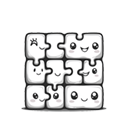Activity
Similar Activities
Nature-Inspired Drawing Activity
Children’s Age: 8–9 years
Activity Duration: 10 – 25 minutes
An outdoor activity where children draw natural elements to foster creativity and ecological awareness.
Activity Duration: 10 – 25 minutes
Ecosystem Adventure Board Game - Nature's Quest
Children’s Age: 7–9 years
Activity Duration: 10 – 25 minutes
An interactive board game where children explore and learn about ecosystems through challenges and tasks.
Activity Duration: 10 – 25 minutes
Animal Feast Adventure: A Whimsical Feeding Frenzy
Children’s Age: 5–8 years
Activity Duration: 10 – 25 minutes
An interactive activity where children feed toy animals with pretend food, promoting communication skills and adaptive development.
Activity Duration: 10 – 25 minutes
Symmetry Magic: Reflective Art Adventure
Children’s Age: 7–10 years
Activity Duration: 10 – 25 minutes
This activity involves exploring symmetry through a creative and interactive art project for children aged 7-10 years.
Activity Duration: 10 – 25 minutes
Bridge Builders: Eco Teamwork and Critical Thinking
Children’s Age: 8–9 years
Activity Duration: 10 – 25 minutes
An eco-conscious activity where children build bridges using popsicle sticks and tape to support toy cars, promoting teamwork and environmental awareness.
Activity Duration: 10 – 25 minutes
Cultural Collage Creations: Exploring World Wonders Together
Children’s Age: 7–9 years
Activity Duration: 10 – 25 minutes
Let's embark on a creative journey with "Cultural Collage Creations"! This educational craft project invites children to explore diverse cultures through art. Gather supplies and c…
Activity Duration: 10 – 25 minutes
Whispers of Nature Rhythms: Exploring Beats and Patterns
Children’s Age: 3–7 years
Activity Duration: 10 – 30 minutes
Let's explore "Nature Rhythms" together! We will listen to nature's beats and patterns using rocks, sticks, leaves, and pinecones. Find a safe outdoor spot, gather natural material…
Activity Duration: 10 – 30 minutes
Sensory Texture Hunt for Developing Skills
Children’s Age: 4–7 years
Activity Duration: 5 – 10 minutes
Let's go on a Sensory Treasure Hunt! We will explore different textures like smooth stones, soft feathers, and rough sandpaper. You can use blindfolds for an extra challenge if you…
Activity Duration: 5 – 10 minutes
Mini Compost Bin Creations: Earth's Garden Journey
Children’s Age: 4–6 years
Activity Duration: 15 – 20 minutes
Children aged 4 to 6 can engage in creating a mini compost bin to explore composting and Earth's natural cycles. Using simple materials like a plastic bin, soil, kitchen scraps, an…
Activity Duration: 15 – 20 minutes
Enchanted Sensory Garden Exploration for Infants
Children’s Age: 0 – 3 months
Activity Duration: 10 minutes
Explore the Sensory Garden with your little one aged 0 to 3 months for a delightful outdoor sensory experience. Enhance communication skills and adaptive development as your infant…
Activity Duration: 10 minutes
Healthy Harvest: Clay Creations - Making Healthy Food Sculptures
Children’s Age: 4–6 years
Activity Duration: 10 – 15 minutes
Engage children in the "Clay Creations - Making Healthy Food Sculptures" activity to boost their adaptive skills, self-care abilities, and academic progress through crafting nutrit…
Activity Duration: 10 – 15 minutes
Garden Sensory Exploration: Nature's Textured Adventure
Children’s Age: 6 months – 1 year
Activity Duration: 5 – 10 minutes
Encourage your child's sensory and motor development with an outdoor garden exploration activity. Lay out a blanket in a safe spot, gather natural items like leaves and rocks, and …
Activity Duration: 5 – 10 minutes


























